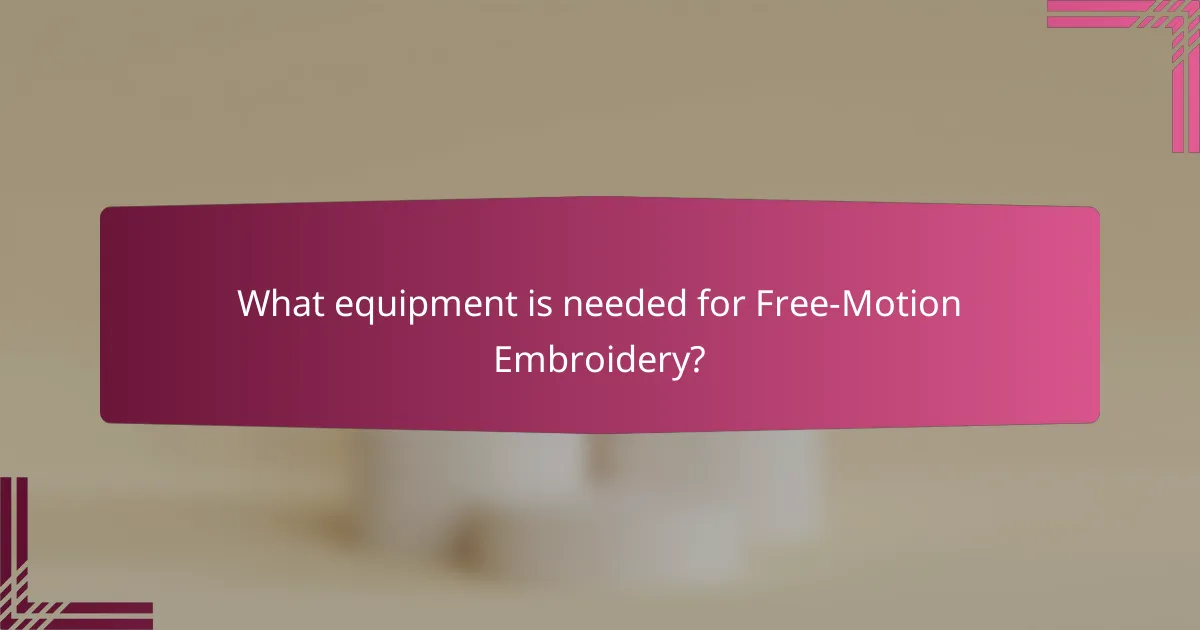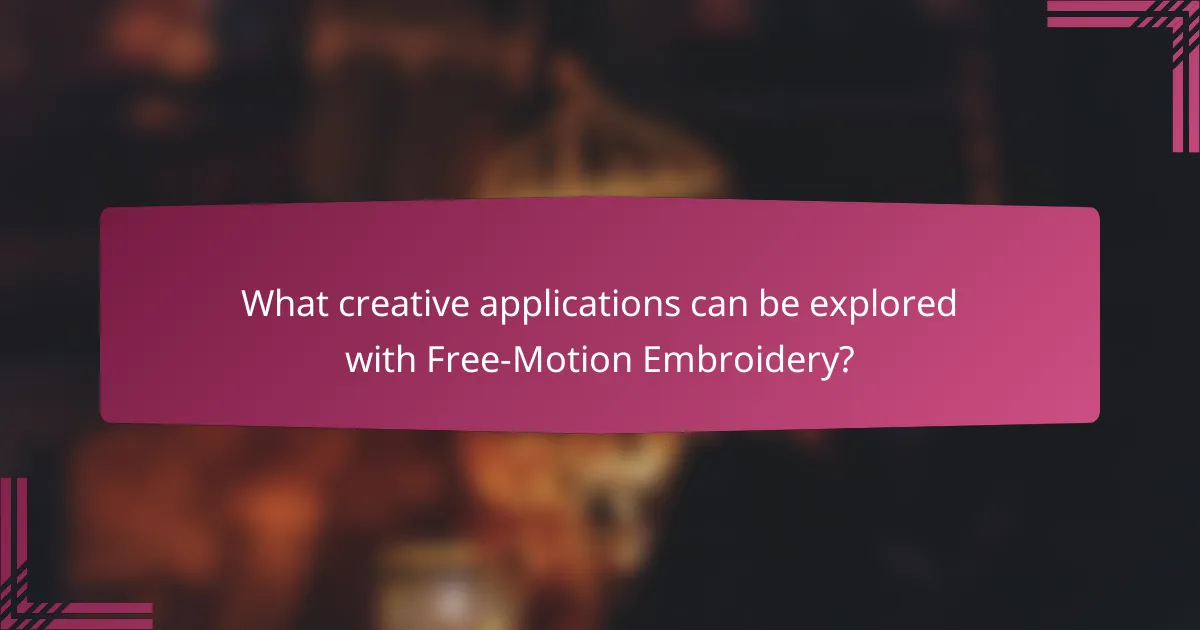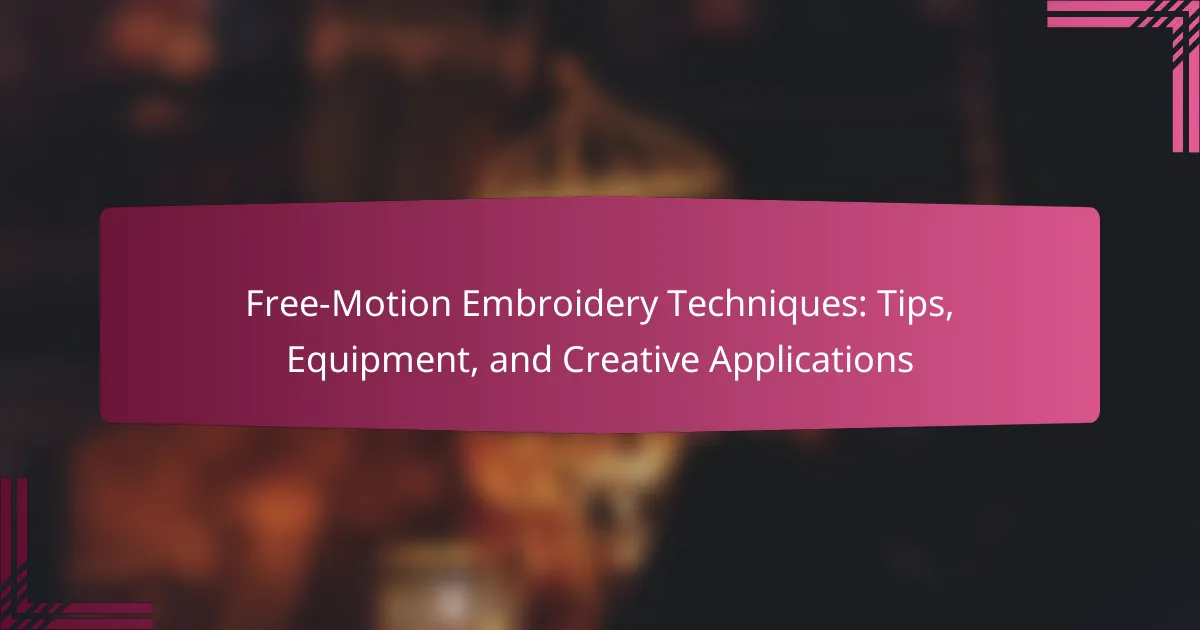
What are Free-Motion Embroidery Techniques?
Free-motion embroidery techniques are methods that allow the embroiderer to move the fabric freely under the sewing machine needle. This technique enables the creation of intricate designs and patterns without following a predetermined path. It requires a specialized foot called a free-motion foot, which allows for unrestricted movement. The embroiderer controls the speed and direction of the fabric, creating unique, freehand designs. This method is popular for artistic embroidery projects, as it offers greater creative freedom. Many artists use it for quilting, appliqué, and embellishing fabric. Free-motion embroidery can be practiced on various fabrics, including cotton and silk. It is essential to practice to master the technique and achieve desired results.
How do Free-Motion Embroidery Techniques differ from traditional embroidery?
Free-motion embroidery techniques differ from traditional embroidery in that they allow for greater freedom of movement and creativity. In free-motion embroidery, the fabric is not moved in a predetermined direction. Instead, the embroiderer moves the fabric in any direction while the needle is sewing. This results in more intricate and personalized designs. Traditional embroidery typically follows a set pattern or design, often using a hoop to keep the fabric taut. Free-motion techniques can create a variety of textures and effects that are not possible with traditional methods. Additionally, free-motion embroidery requires a specialized foot on the sewing machine that disengages the feed dogs, enabling the free movement of fabric. This contrasts with traditional embroidery, where the feed dogs grip the fabric to guide it through the machine.
What skills are required for Free-Motion Embroidery?
Free-motion embroidery requires several key skills. First, a strong understanding of sewing machine operation is essential. This includes knowing how to adjust tension and speed settings. Second, hand-eye coordination is crucial for guiding the fabric smoothly. Third, creativity plays a significant role in designing patterns and motifs. Fourth, patience is necessary for intricate work and detail. Additionally, familiarity with various embroidery techniques enhances the overall quality. Lastly, practice is vital to improve proficiency and confidence in free-motion techniques.
What types of machines are suitable for Free-Motion Embroidery?
Sewing machines that are suitable for free-motion embroidery include both domestic and longarm machines. Domestic machines must have a drop feed feature to allow the fabric to move freely. They should also offer adjustable speed settings for better control. Longarm machines are designed for larger projects and provide a wider throat space for maneuverability. These machines typically have specialized quilting feet for precise stitching. Brands like Bernina, Brother, and Janome are known for their capabilities in free-motion embroidery.
What are the key benefits of using Free-Motion Embroidery Techniques?
Free-motion embroidery techniques offer several key benefits. They allow for greater creativity and artistic expression. This technique enables free movement of the fabric under the needle. It results in unique designs and intricate patterns. Free-motion embroidery can be used on various materials. This versatility enhances project possibilities. Additionally, it improves sewing skills and hand-eye coordination. Many crafters find it enjoyable and fulfilling.
How does Free-Motion Embroidery enhance creativity?
Free-motion embroidery enhances creativity by allowing artists to create intricate designs without the constraints of a fixed stitch pattern. This technique enables the free movement of fabric under the needle, fostering spontaneity in artistic expression. Artists can explore various patterns, textures, and motifs, leading to unique and personalized creations. The ability to manipulate the fabric freely encourages experimentation with different thread types and colors. Studies show that engaging in such creative activities can stimulate brain function and improve problem-solving skills. This form of embroidery also promotes mindfulness, as it requires focus and attention to detail, further enhancing the creative process.
What are the time-saving aspects of Free-Motion Embroidery?
Free-motion embroidery is time-saving due to its flexibility and efficiency. It allows for rapid stitching without the need for intricate machine setups. Users can create complex designs quickly by guiding the fabric manually. This method eliminates the need for multiple hoop changes, saving setup time. Additionally, free-motion techniques enable faster completion of projects compared to traditional methods. The ability to stitch in any direction reduces the time spent on planning and positioning. Overall, free-motion embroidery streamlines the creative process, making it more efficient for users.

What equipment is needed for Free-Motion Embroidery?
Free-motion embroidery requires a sewing machine capable of free-motion stitching. This machine should have a drop feed mechanism to allow the fabric to move freely. Additionally, a darning or free-motion foot is essential for proper stitching control. A variety of embroidery threads are also needed to achieve different effects. Stabilizers are important to support the fabric during stitching. Scissors for trimming threads and a hoop may be useful for holding fabric in place. Together, these tools enable effective free-motion embroidery techniques.
What types of sewing machines are best for Free-Motion Embroidery?
The best types of sewing machines for free-motion embroidery are those with a drop feed feature and adjustable speed settings. Machines with a wide throat space are also ideal, as they provide more room for maneuvering fabric. Brands like Bernina, Janome, and Brother offer models specifically designed for this technique. These machines typically include a free-motion foot to facilitate smooth stitching. Additionally, a strong motor is essential for handling various fabric types. Many of these machines also feature built-in stitch patterns that enhance creative possibilities. Users often prefer machines with easy needle position adjustments for better control.
How do various sewing machine features impact Free-Motion Embroidery?
Various sewing machine features significantly impact Free-Motion Embroidery. Key features include the type of feed dogs, stitch speed control, and needle options. Machines with drop feed dogs allow for better fabric manipulation during free-motion work. Adjustable stitch speed control enables precise movements, reducing the risk of errors. Specialized needles, such as embroidery or quilting needles, enhance the quality of stitches. Additionally, a larger throat space accommodates bigger projects, facilitating easier handling. Machines equipped with a free-motion foot provide better visibility and control. These features collectively enhance the quality and creativity of Free-Motion Embroidery projects.
What accessories are essential for Free-Motion Embroidery?
Essential accessories for free-motion embroidery include a free-motion foot, quality embroidery thread, and a stabilizer. A free-motion foot allows for unrestricted movement of the fabric while stitching. Quality embroidery thread ensures vibrant colors and durability in the design. A stabilizer supports the fabric, preventing puckering and distortion during the embroidery process. Additionally, a needle suitable for the fabric type is crucial for achieving clean stitches. A hoop or frame can help keep the fabric taut. Proper lighting is also important for visibility and precision while working. These accessories collectively enhance the free-motion embroidery experience.
What tools can improve Free-Motion Embroidery quality?
High-quality tools that can improve Free-Motion Embroidery include specialized presser feet, high-quality threads, and stabilizers. A darning foot or free-motion quilting foot allows for better control during stitching. Using high-quality threads minimizes breakage and enhances the final appearance. Stabilizers provide necessary support to the fabric, preventing distortion. Needle choice also impacts quality; using the correct needle type for the fabric ensures smoother stitching. Additionally, a reliable sewing machine with good tension control is essential for consistent results. These tools collectively enhance the precision and finish of free-motion embroidery projects.
How do different types of needles affect Free-Motion Embroidery?
Different types of needles significantly affect Free-Motion Embroidery by influencing stitch quality and fabric handling. For instance, ballpoint needles are ideal for knit fabrics, as their rounded tips prevent snagging. Conversely, sharp needles work best on woven fabrics, delivering precise stitches. The size of the needle also matters; larger needles create bigger holes, affecting the fabric’s integrity. Specialty needles, like embroidery needles, have a larger eye, allowing thicker threads to pass through easily. These variations lead to different textures and finishes in the embroidery work. Proper needle selection can enhance the overall appearance and durability of the finished piece.
What role do threads play in Free-Motion Embroidery results?
Threads are crucial in determining the quality and appearance of Free-Motion Embroidery results. The type of thread affects the stitch definition and texture. Different threads, such as cotton, polyester, and rayon, offer varied sheen and durability. Thicker threads create bolder designs, while thinner threads allow for finer details. The color of the thread influences the overall visual impact of the embroidery. Additionally, the tension settings must be adjusted based on the thread type to achieve optimal results. Proper thread selection enhances the finished piece’s aesthetic and longevity.

What creative applications can be explored with Free-Motion Embroidery?
Free-motion embroidery can be used for various creative applications. Artists often create intricate designs on fabric. This technique allows for personalized embellishments on garments. It can also be utilized for making unique home decor items. Free-motion embroidery is popular for quilting projects, enhancing texture and detail. Many crafters use it to produce custom patches and appliqués. Additionally, it can be applied in mixed media art, combining fabric with other materials. Its versatility makes it suitable for both functional and artistic creations.
How can Free-Motion Embroidery be used in home decor?
Free-motion embroidery can be used in home decor to create unique and personalized textile art. This technique allows for intricate designs on various fabric items. Common applications include decorative pillows, wall hangings, and table runners.
Free-motion embroidery enables the artist to manipulate the fabric freely under the needle. This results in custom patterns and textures that enhance the aesthetic of a space. Additionally, it can be used to embellish curtains or quilts, adding a personal touch to home interiors.
According to a study by the Craft & Hobby Association, DIY home decor projects have increased in popularity, with embroidery being a favored technique among crafters. The versatility of free-motion embroidery makes it an ideal choice for those looking to elevate their home decor with handmade elements.
What are some popular designs for Free-Motion Embroidery in home decor?
Popular designs for free-motion embroidery in home decor include floral patterns, geometric shapes, and abstract art. Floral designs often feature intricate petals and leaves, adding a natural touch to textiles. Geometric shapes provide a modern aesthetic, often using repeated patterns for visual impact. Abstract art allows for creative expression, with free-form designs that can be personalized. Additionally, animal motifs are popular, bringing a whimsical element to decor. These designs enhance items like cushions, wall hangings, and table runners, making them visually appealing and unique.
How can Free-Motion Embroidery personalize gifts?
Free-motion embroidery can personalize gifts by allowing custom designs and messages to be stitched onto fabric. This technique enables crafters to create unique patterns that reflect the recipient’s personality or interests. By using various thread colors and styles, each piece becomes a one-of-a-kind item. Personalization can include names, dates, or special symbols, enhancing the emotional value of the gift. The versatility of free-motion embroidery makes it suitable for a wide range of items, from clothing to home decor. This method not only adds a personal touch but also showcases the giver’s thoughtfulness and creativity.
What are some innovative projects that utilize Free-Motion Embroidery?
Innovative projects that utilize Free-Motion Embroidery include textile art installations, wearable art pieces, and personalized home decor. Textile art installations often feature intricate designs that showcase the artist’s creativity. Wearable art pieces can transform clothing into unique fashion statements. Personalized home decor items, such as embroidered wall hangings, add a custom touch to interior spaces. These projects highlight the versatility of Free-Motion Embroidery in various creative fields. Artists and designers are increasingly adopting this technique for its ability to produce detailed and expressive patterns.
How can Free-Motion Embroidery enhance wearable art?
Free-motion embroidery enhances wearable art by allowing intricate designs and textures. This technique provides artists with the freedom to create detailed, personalized patterns. It enables the use of various threads and fabrics, adding depth to the artwork. Artists can manipulate the fabric freely under the needle, resulting in unique, one-of-a-kind pieces. The versatility of free-motion embroidery allows for both subtle accents and bold statements. This method also encourages experimentation with different styles and techniques. As a result, wearable art becomes a canvas for self-expression and creativity. The final pieces often stand out due to their craftsmanship and artistic flair.
What are some examples of Free-Motion Embroidery in fashion design?
Free-motion embroidery in fashion design includes various applications such as intricate floral patterns, abstract designs, and personalized monograms. Designers often use it to create texture and depth on garments. For instance, brands like Gucci and Alexander McQueen have incorporated free-motion embroidery in their collections. This technique allows for detailed customization on jackets, dresses, and accessories. The flexibility of free-motion embroidery enables artists to explore unique artistic expressions. Additionally, it is used in haute couture for embellishing fabrics with complex motifs. These examples showcase the versatility and creativity of free-motion embroidery in contemporary fashion design.
What tips can help beginners succeed in Free-Motion Embroidery?
Start with a quality sewing machine designed for free-motion embroidery. Ensure it has a drop feed feature. Use a free-motion embroidery foot for better control. Choose the right needle and thread for your fabric type. Practice on scrap fabric before working on actual projects. Maintain a steady speed while moving the fabric. Experiment with different designs and techniques to build confidence. Regularly clean and maintain your machine for optimal performance. These tips help beginners develop skills and enjoy the process of free-motion embroidery.
How can beginners practice Free-Motion Embroidery effectively?
Beginners can practice Free-Motion Embroidery effectively by starting with a simple setup. Use a sewing machine equipped with a free-motion foot. Select a basic fabric and thread to minimize distractions. Begin with practice stitches on scrap fabric to build confidence. Focus on controlling the speed of the machine while moving the fabric smoothly. Gradually introduce different designs, starting with basic shapes. Consistent practice helps improve muscle memory and coordination. Resources like online tutorials can provide visual guidance and tips.
What common mistakes should beginners avoid in Free-Motion Embroidery?
Beginners in free-motion embroidery should avoid several common mistakes. One major mistake is not practicing enough before starting a project. Practice helps in gaining control over the machine. Another mistake is using the wrong needle type or size. A suitable needle prevents skipped stitches and fabric damage. Beginners often forget to lower the feed dogs. This adjustment is essential for free-motion techniques. Additionally, not securing the fabric properly can lead to uneven stitching. Proper basting or hooping keeps the fabric stable. Lastly, beginners may rush the process. Taking time ensures precision and quality in the final piece.
Free-motion embroidery techniques allow embroiderers to move fabric freely under the sewing machine needle, enabling the creation of intricate and personalized designs. This article covers the differences between free-motion and traditional embroidery, the skills and equipment required, and the benefits of this creative method. It also explores various applications in home decor and fashion design, offers tips for beginners, and highlights common mistakes to avoid. Additionally, the article discusses essential accessories and tools that enhance the quality of free-motion embroidery projects.
